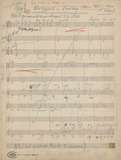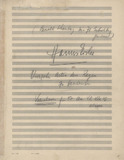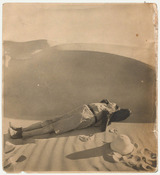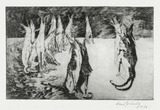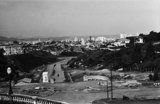Hanns Eisler: Song of the United Front, score (1935)
This is how the composer Hanns Eisler described his impressions of the Reichenberg music festival in summer 1935. Eisler, who had fled from the Nazis in 1933, went on various work and concert tours in Europe and Russia during this time.
Hanns Eisler: The Woodbury Songbook (1941)
20 songs for a girls' choirComposer Hanns Eisler and his wife Lou spent summer 1941 in Woodbury – a small town in the American state of Connecticut. They were the guests of their fellow emigrant – the author Joachim Schumacher.
Hanns Eisler: Vierzehn Arten den Regen zu beschreiben, Manuscript (1941)
[Fourteen Ways to Describe Rain]The composition Fourteen Ways to Describe Rain (Vierzehn Arten, den Regen zu beschreiben) is closely linked to Hanns Eisler' s situation in exile. The piece, today among Eisler’s most important compositions, was originally film music.
Hanns Kralik: Das Moorsoldatenlied, song sheet (1933)
Singing as an act of resistanceCommunal singing by inmates was an everyday act of self-assertion and an identity and community-building strategy. Several hundred songs are now believed to have been composed in the camps.
Hans Casparius: photograph of Richard A. Bermann in the Libyan desert (1933)
Photographer Hans Casparius had already accompanied writer and journalist Richard A. Bermann (alias Arnold Höllriegel) on numerous journeys and taken photos for his reports.
Hans Fallada: Letter to Carl Ehrenstein (1935)
Despite the hostilities of the National Socialists, the author Hans Fallada could never bring himself to leave Germany and go into exile after 1933. In the early years of Hitler’s regime his books were almost entirely rejected by the Nazi functionaries, including his novel Altes Herz geht auf die Reise, alluded to in the following letter.
Hans Fallada: Letter to Carl Ehrenstein (1937)
The author Hans Fallada could never bring himself to leave Germany and go into exile after 1933. He rather opted for a sort of “inner exile,“ associated with a passive aversion of the NS system.
Hans Grundig: Das Lied der Wölfe, etching (The Song of the Wolves, 1938)
The couple Hans and Lea Grundig began an underground life in 1933, withdrawing into a domestic exile. They entertained thoughts of escaping but the two anti-fascists saw their task as supporting resistance within Germany.
Hans Günter Flieg: last photograph in Chemnitz and first photograph in São Paulo (1939)
The photographer Hans Günter Flieg emigrated to Brazil with his family in 1939. Some time later he discovered a strip of negative film which contained the last photograph he had taken in Chemnitz and the first one in São Paulo right next to one another.
Hans Günter Flieg: Photograph of São Paulo (1940)
This photo, which the then 17-year-old Chemnitz-born photographer Hans Günter Flieg took in Brazilian exile in 1940, offers a view of central São Paulo and its Avenida Nove de Julho. It came just a year after the Jewish Flieg family had emigrated from Germany to Brazil.
![Das Lied von der Einheitsfront [Song of the Unified Front] Das Lied von der Einheitsfront [Song of the Unified Front]](/KIE/Content/EN/Images/objects/eisler-lied-der-einheitsfront-01-en.jpg?__blob=thumbnail&v=3)
![Das Lied von der Einheitsfront [Song of the Unified Front] Das Lied von der Einheitsfront [Song of the Unified Front]](/KIE/Content/EN/Images/objects/eisler-lied-der-einheitsfront-01-en.jpg?__blob=thumbnail&v=3)
